Network Rollups for Multi-Site Publishers
A common question for digital media executives at major web publishing companies is: should we take a single-site strategy, or a multi-site strategy?
Compare, for example, a company like The New York Times, with its single destination site nytimes.com, to a media company like Gawker Media, which runs gawker.com, gizmodo.com, jezebel.com, and several other sites. Each strategy seems to work well in different ways and for different audiences.
A long-standing request from Parse.ly customers who elect to use a multi-site strategy was to be able to treat those sites as though they were a single large site, from the standpoint of content engagement metrics like page views, visitors, shares, and engaged time. This is a tall technical order, as it means having a backend flexible enough to rollup data collected from several domains, and a dashboard user interface flexible enough to display the results. Indeed, many of the top analytics platforms on the market make it extremely difficult to pull this off — and in some, it’s actually impossible!
However, I’m pleased to say that at Parse.ly, this is now a solved problem. Today, we’re announcing our Network Rollup feature. This makes it possible to rollup data from multiple sites into a single “network view.” Access to this feature is available in our “Data Pros” tier.
So, if you’re:
- a fast-growing media company that is building an empire via site acquisitions; or
- a network of local newspapers spread across the country; or
- an international media conglomerate with several destination sites representing different brands; or
- a tapestry of related sites all reporting on a different facet on the same industry
… you can now get that much-needed “bird’s-eye view” of how all your posts, authors, sections, tags, and traffic sources are performing across your entire network of sites.
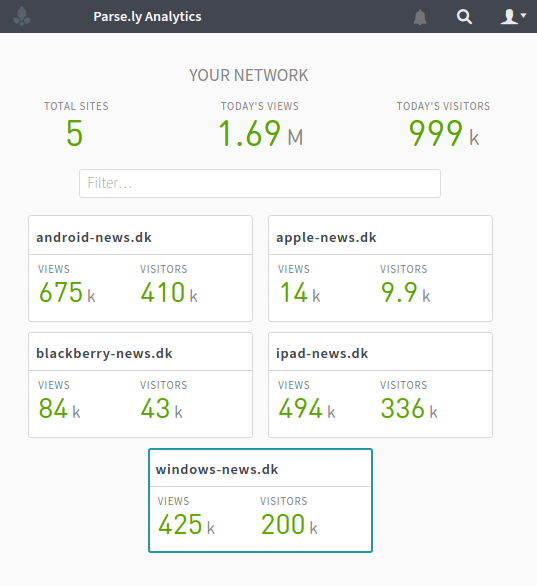
For multi-site publishers, the entry point into Parse.ly is a summary of how your network is doing. You can click into any individual site. To switch to the “Network Rollup” view, you just need to select your company name from the site selector in the top left.

In this case, the company’s name is “Intl Digital Media Co, Inc” and it runs five sites, android-news.dk, apple-news.dk, blackberry-news.dk, ipad-news.dk, and windows-news.dk. As you can see, here is a tech publisher that has specialized each of its sites to a specific topic area.
Let’s take a look at some Parse.ly customers as examples of why Network Rollup is valuable.
Conde Nast is one of the world’s premier media companies, and is the home of several cherished brands (many of which started as popular magazine titles), including wired.com, newyorker.com, and vanityfair.com.
With the new “Network View,” Conde Nast executives can now see how posts are performing across their entire network of Conde Nast properties. So whether a long-form story is trending on The New Yorker, a celebrity profile piece is going viral on Vanity Fair, or a tech deep-dive is engaging readers on Wired, executives can see all of that content rolled up in a single dashboard. What’s more, Conde Nast can more flexibly do cross-site studies.
Want to know how engaged time per story compares from The New Yorker to Wired? Only a click away. Want to study the virality of different content types across all Conde Nast properties? Use a single “tag” to identify the content type, and then consistently tag all your content from site-to-site. In the network view, you can now get the rollup and drill-down details of how that content type performs across all your sites, and start to study the differences.
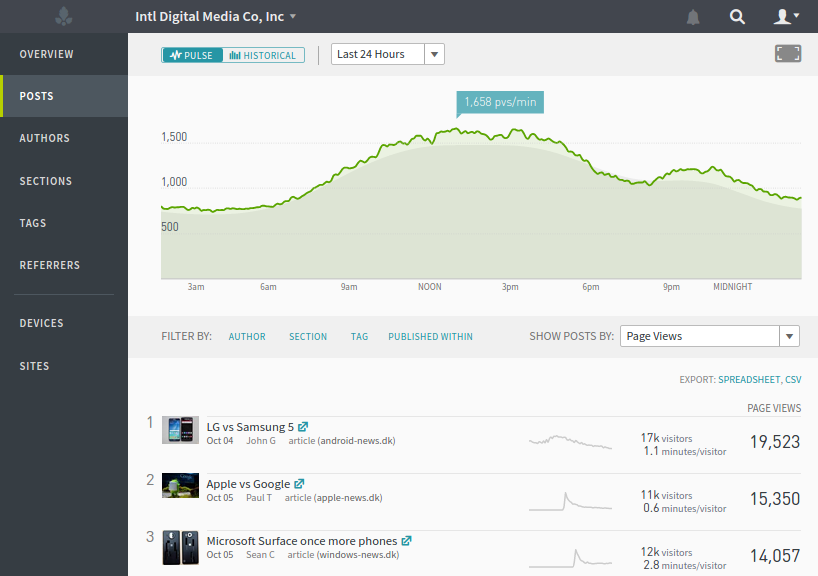
Mobile Nations is a network of related mobile-focused websites, such as androidcentral.com, imore.com, crackberry.com, and connectedly.com. The site features a slew of helpful how-to and informational content, whose traffic tends to depend on the buying cycle for consumer mobile devices. The flexible staff at Mobile Nations can be cross-applied to writing about iOS devices or Android devices depending on current search and social trends, while also understanding the differences in readership habits among loyalists of various mobile device operating systems. Executives at the company can rollup all this traffic by site and author, in order to cross-assign authors from one site to another.
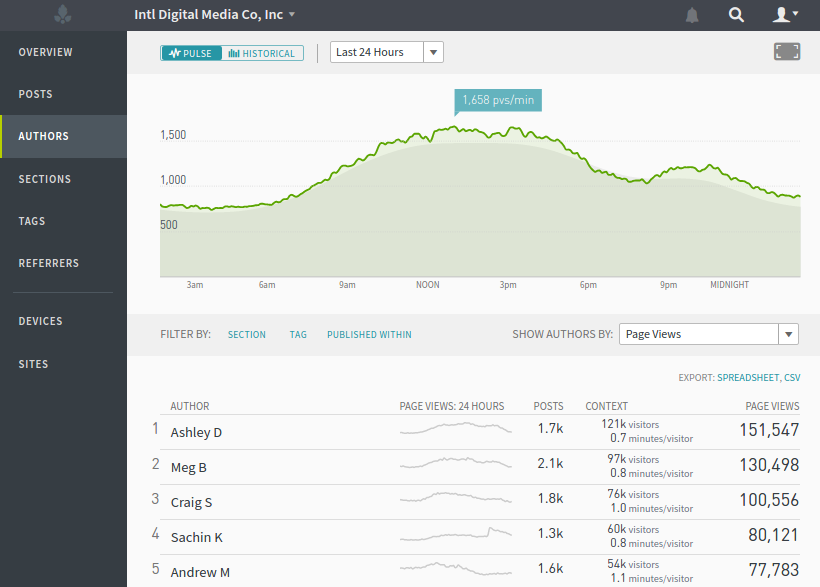
GateHouse Media is a large media holding company for many local newspapers across the country. It is now rolling out a strategy to digitize its newsrooms, and Parse.ly is an integral part of that effort. Interestingly, the GateHouse Media strategy is to leverage its network of sites as much as possible. Journalists are given access to not just the panel for their local news destination, but also the panel for the “network view” of all the GateHouse Media news sites across the country. This lets local news journalists understand national trends, and allows the company to do smart cross-syndication of content across its properties. The “Overview” screen in Parse.ly, which is projected in several newsrooms on large TV displays, can now be toggled into “Network Overview” mode to show how the entire company’s content is performing, in real-time, across potentially hundreds of sites.

Finally, Batanga Media is an independent media company whose properties include Batanga.com, iMujer.com, and BolsadeMulher.com. Batanga is one of the largest networks of sites based in the U.S. whose audience is primarily Hispanic. The “Network Rollup” allows Batanga to showcase the reach of its unique audience to advertisers. It also allows the company to test how its social strategies work at scale across all its sites. For example, filtering Facebook traffic under the network view shows the top posts getting traffic in the past 5, 10, or 15 minutes from the social network, regardless of which destination site is receiving that traffic.
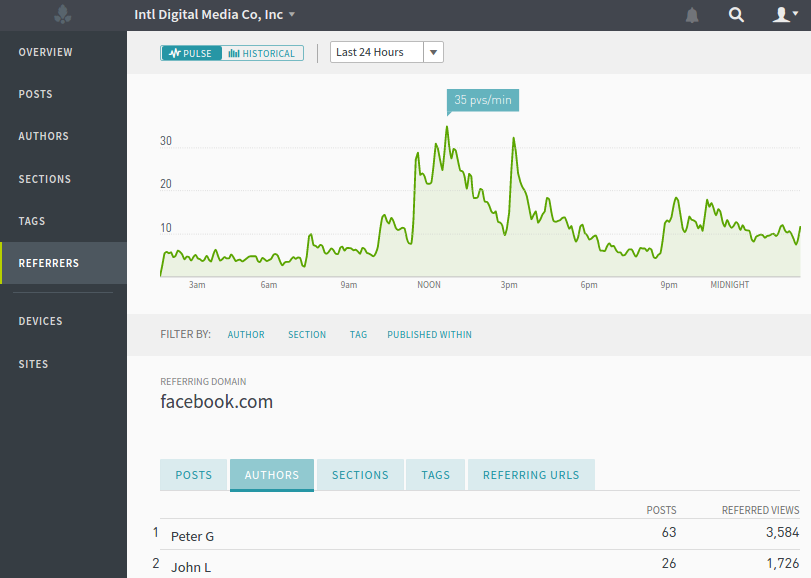
One last thing — when in the Network Rollup view, you won’t have access to the pre-configured “Reports” tab. That’s because though the rollup view is available for all the real-time and historical data in the dashboard, for simplicity purposes, we kept the reporting suite focused on single sites.
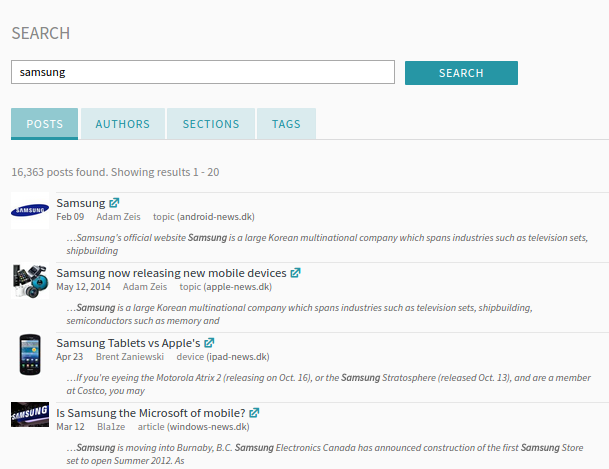
However, one Network Rollup feature you may find especially fun is our Unified Dashboard Search. You can type a search keyword into our search bar while in the Network Rollup view, and it will search that keyword across the content of all your sites. Here’s an example of “samsung” as a keyword getting hits from posts spread across four sites. We believe Parse.ly’s New Network Rollup is a powerful new tool in any media executive’s arsenal. It has been proven time and time again that in online media, “the sum of the parts is greater than the whole.” That is, often a network of sites targeting different niche audiences can be stronger than a single destination.
Both models work for different companies, but until today, the multi-site model had with it a slew of technical challenges around analytics instrumentation. Parse.ly has now solved those issues, and multi-site networks can be just as easily analyzed at scale as single destination sites.
What’s more, old dogs can learn new tricks! Owners of successful single destination websites can now feel comfortable experimenting with a new destination site. See, for example, First Look Media’s Reported.ly or Al Jazeera’s Stream. You no longer need to worry that the launch of a new site means the loss of unified content analytics data across all your sites.
This is all part of our broad mission to make content analytics easy, democratizing, and fun. How will you use the new Network Rollup feature? Let us know on Twitter — send a message to @Parsely!
About The Changelog
The Changelog posts document changes to the Parse.ly dashboard through the eyes of co-founder and CTO, Andrew Montalenti. Interested in trying out the changes for yourself? Login to your Parse.ly account, or sign up to get started with Parse.ly today.